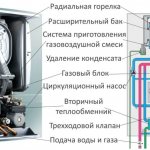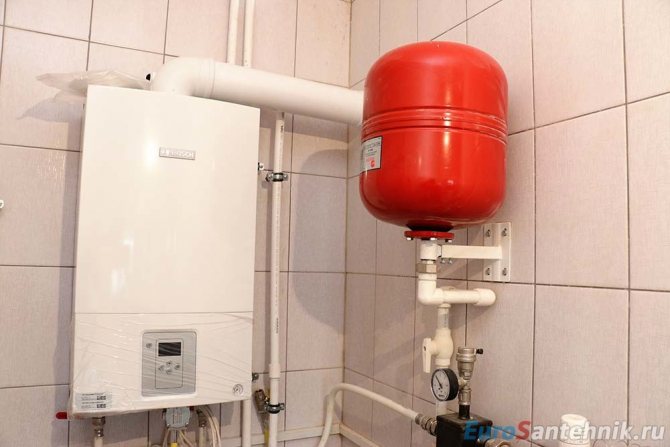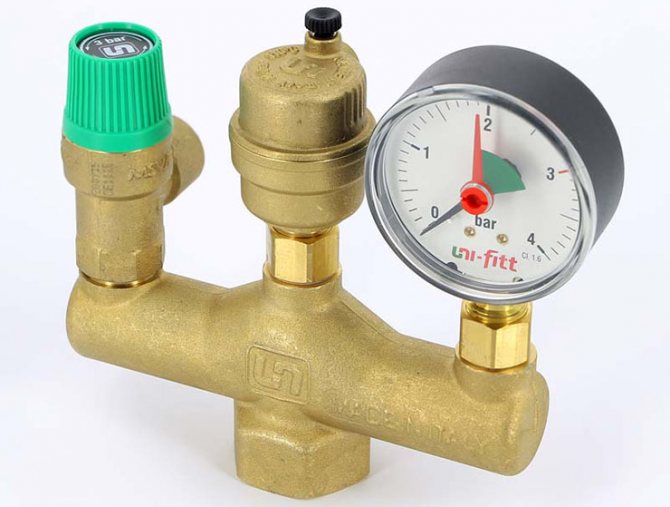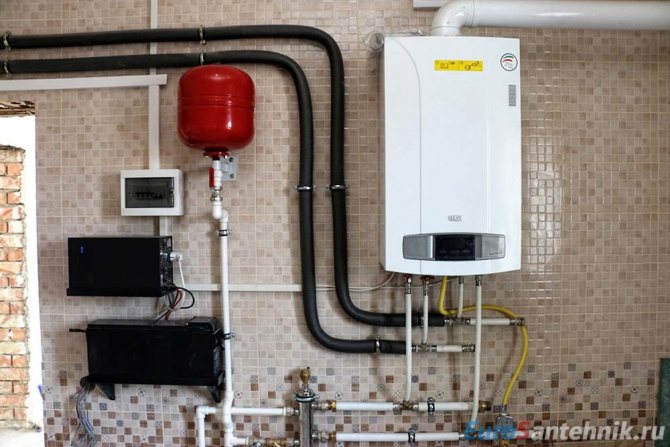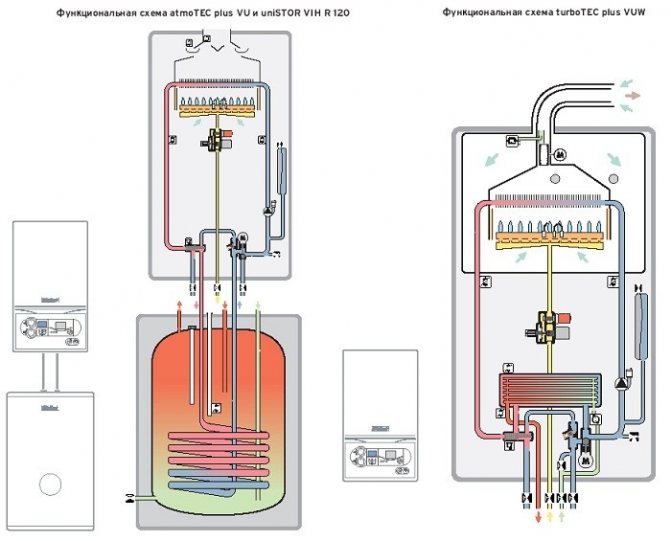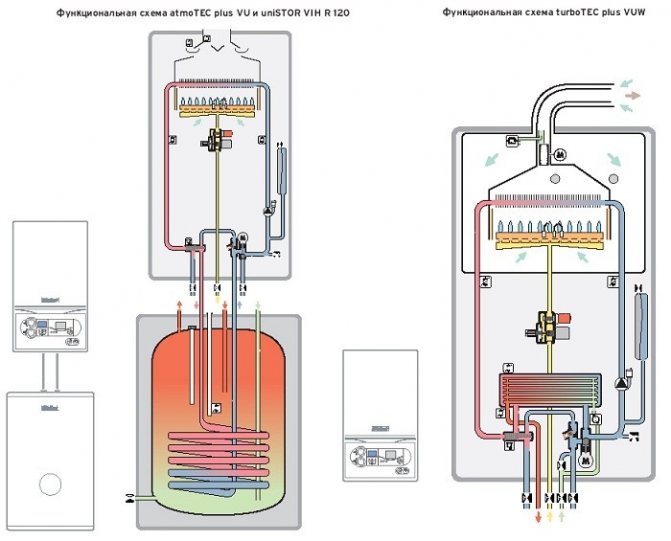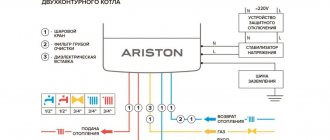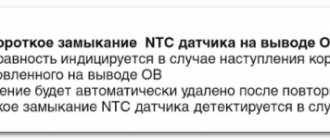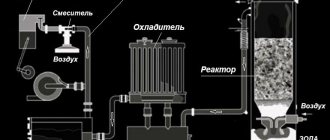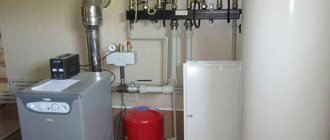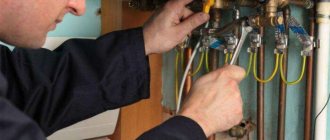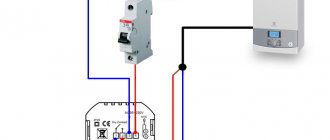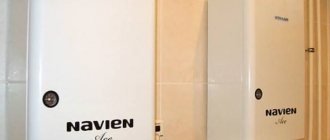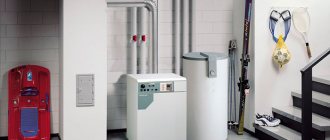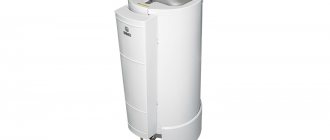The principle of the boiler
Gas heaters may differ structurally and in technical parameters, but the principle of creating heat in a house is the same - heating the coolant (water / antifreeze) with combustion gas (natural / liquefied). The supply of gaseous fuel to a dwelling is not the easiest and safest thing to do, but consumers are attracted by gas, its comparative cheapness and versatility.
Blue fuel can be used not only for heating, but also for heating domestic water using columns or dual-circuit heater models. Modern equipment is equipped with effective security systems that prevent all possible emergencies. Nevertheless, there are operating rules that are mandatory and are a guarantee of safe operation.
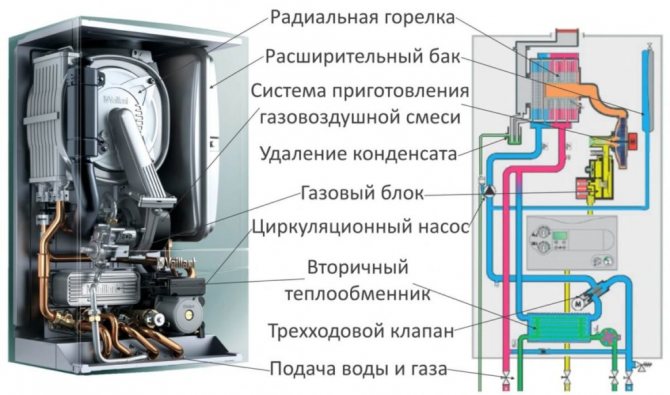
The principle of operation of gas boilers
A gas boiler is the main heating element of the heating system, hot water supply in the house. There are the following varieties, types of heating gas boilers:
- floor;
- wall-mounted;
- single-circuit;
- double-circuit;
- atmospheric;
- turbocharged.
Each type has differences, but the basic principle of operation is the same for all types - through the combustion of gas, the heat carrier circulating in a closed system loop is heated. The second name of the system is a circulation circuit. More often, the coolant is water that has passed the water treatment cycle... The preparation cycle keeps the circulation pipes in working order for a long time, due to the absence of scale on the walls.
In addition to the boiler itself, the following devices are included in the circulation system: circulation pumps, boilers, shut-off valves and heat exchange devices (radiators, batteries).
Precautions
Despite the desire of manufacturers for the safety of gas appliances, they can still become a source of danger. The Ministry of Emergency Situations regularly reminds the owners of any gas-powered equipment about the precautions:
- It is necessary to buy gas-fired appliances from organizations that have an appropriate sales license.
- Installation should only be carried out by qualified personnel.
- The set should include an instruction manual.
- It is forbidden to change the structure of the device in any way.
- A technical check must be carried out annually.
- It is forbidden to reduce ventilation openings in windows and walls.
- In the presence of sealed windows, it is necessary to organize the flow of air.
- Do not store materials that can quickly ignite in the boiler room.
- It is forbidden to increase the temperature of the heating medium over 90 ° C.
USER'S MANUAL BOILER TYPE DE
General Provisions
1. The instructions contain general instructions for the operation of DE type steam boilers, on the basis of which, in relation to specific conditions, taking into account instrumentation, for each boiler house its own production instruction is developed, approved by the chief engineer of the enterprise.
The production instruction and the operational diagram of the boiler room pipelines must be posted at the workplace of the boiler room operator.
2. Install, maintain and operate DE type steam boilers in accordance with the Boiler Regulations.
3. Instructions on the operation of the burner, economizer, automation system and boiler auxiliary equipment are contained in the relevant instructions of the equipment manufacturers.
four.Installation, maintenance and operation of boiler room pipelines should be carried out in accordance with the Rules for the Construction and Safe Operation of Steam and Hot Water Pipelines
5. The owner of the boiler receives from the manufacturer a boiler passport, which, when the boiler is handed over to the new owner, is given to the latter.
The passport, in the appropriate section, indicates the number and date of the order of appointment, position, surname, name, patronymic of the person responsible for the good condition and safe operation of the boiler, the date of testing his knowledge of the Boiler Rules.
The specified person enters into the Passport information on the replacement and repair of boiler elements operating under pressure, and also signs the results of the survey.
6. Acceptance of a newly installed boiler into operation must be carried out after its registration with the Gosgortekhnadzor authorities and technical certification on the basis of an act of the State or working commission on the acceptance of the boiler into operation.
The boiler is put into operation by a written order from the administration of the enterprise after checking the readiness of the boiler plant equipment for operation and organizing its maintenance.
7. In addition to the passport of the boiler in the boiler room, it is necessary to have a repair log, a water treatment log, a control check log of pressure gauges, a replacement log of the operation of boilers and auxiliary equipment.
8. Maintenance of boilers may be entrusted to persons at least 18 years of age who have passed honey. certification, training and having a certificate for the right to service boilers in accordance with the requirements of subsection 9.2. Boiler rules.
Inspection and preparation for kindling boilers type DE
1. Check the water supply in the deaerator, the serviceability of the feed pumps and the presence of the required pressure in the feed line, power supply of the automation panels and actuators;
2. Make sure that the boiler elements and fittings are in normal condition and that there are no foreign objects in the firebox and gas ducts;
3. Check the condition and density of the screen between the furnace and the convective beam;
4. Check the integrity of the protective lining of the drum, the presence and thickness of the asbestos membrane of explosive safety devices;
5. Check the readiness for start-up and operation of the blower fan and the smoke exhauster. From the panel, test the remote control of the guide vanes, check the correctness of their adjustment for full opening and closing;
6. If the boiler is started up after repairs, during which the boiler drums were opened, then before closing them, make sure that there is no dirt, rust, scale and foreign objects; check the cleanliness of the pipe connecting the sections of the boilers with a steam capacity of 16 and 25 t / h; check the absence of damage to the elements of the steam separation and inside the drum devices and the loosening of the joints of the baffle plates, the guiding caps, the tightness of their abutment to the drum and the partition; before installing new gaskets, carefully clean the junction plane from the remnants of the old gaskets; lubricate gaskets and bolts with a mixture of graphite powder and oil during assembly to avoid burning;
7. Check the correct installation and ease of rotation of the blower tubes. The axes of the nozzles of the blow-off pipes must be centered in the gaps between the boiler pipes;
8. Make sure of: normal condition of the burner parts, burner lance, front wall lining, drums;
9. Check the correct assembly of the burner nozzles.
It is recommended to check the assembly and spray quality of the nozzle at the bench by connecting water instead of fuel, and compressed air instead of steam.
In the nozzle of the GMP-16 burner, the pressure of the steam supplied to atomize the fuel affects the angle of the open fuel flame.With an increase in the steam pressure for spraying during ignition from 0.1 MPa (1 kgf / cm2) to 0.25-0.3 MPa (2.5-3.0 kgf / cm2), a decrease in the spray angle from 65 ° to 30 ° is achieved. , in which there is no coking of the walls of the two-stage fuel combustion chamber.
Visual control of the initial ignition zone and the exit edge of the embrasure or combustion chamber is carried out through the front hatch of the right side wall.
Fuel oil temperature in front of the nozzle should be within 110 -130 ° С, viscosity should not exceed 3 ° VU;
10. After inspecting the firebox and gas ducts, close the manholes and hatches tightly;
11. After checking the serviceability of the valve, make sure that:
- the boiler purge valves are tightly closed, and in the presence of a superheater, the purge valve on the superheated steam chamber is open;
- drain valves of the economizer and boiler are closed;
- boiler and economizer pressure gauges in working position, i.e. pressure gauge tubes are connected by three-way valves with the medium in the drum and economizer;
- direct mode level indicators are on, i.e. steam and water valves (taps) are open and purge valves are closed;
- the main steam shut-off valve and the “auxiliary steam” valve are closed;
- the economizer air vents are open.
To release air from the boiler, open the steam sampling valve on the drum and at the sample cooler.
12. Fill the boiler with water with a temperature not lower than + 5 ° С in the following sequence:
- after turning on the feed pump (which is carried out according to the relevant instructions) and supplying water to the economizer, the valve of one of the supply lines opens slightly.
After the appearance of clarified water, the economizer air vent is closed. The boiler is filled to the lower level in the direct-acting water level indicator glass. If the boiler is filled up for the first time after repairs, it must be flushed by filling it with water twice to the upper level and discharging it through the blowdown and drainage.
The time of filling the boiler with water and its temperature must be indicated in the order for kindling.
When filling the boiler, check the tightness of the manhole and hatch gates, flange connections, the tightness of the fittings (the passage of the latter can be judged by the heating of the pipes after the valves, if the boiler is filled with warm water).
If leaks appear in manhole and hatch gates and flange connections, tighten them; if the leak persists, interrupt the power supply to the boiler, drain the water and replace the gaskets.
After raising the water in the boiler to the lower mark of the level indicator, cut off the power supply to the boiler.
After that, you should check if the water level in the glass is kept. If it goes down, you need to find out the reason, eliminate it, and then recharge the boiler to the lowest level.
If the water level in the boiler rises with the feed valve closed, which indicates a pass, it is necessary to close the previous valve along the way.
13. Check by switching on the serviceability of the main and emergency lighting;
14. Make sure that the instrumentation and control system of the boiler is in good working order, check the fuel cut-off using simulated parameters;
15. Check the serviceability of the boiler gas equipment and the ignition-protective device. If the boiler is preparing for firing up with fuel oil, let the fuel go through the circulation circuit;
16. Supply steam from neighboring boilers to the heating line of the lower drum and heat the water in the boiler to 95-100 ° C.
Preheating the water will reduce the thermal stresses in the metal of the lower boiler drum that arise during firing up due to temperature differences between the wall of the upper part, washed by hot combustion products, and the lower part, in contact with relatively cold water.
content .. 1 2 3 8 ..
Accommodation rules
- The area of the room in which the heater is installed is at least 7.5 m².
- Ceilings - from 2.2 m.
- There should be a window that allows air access from the street.
- The door should open in the direction of the movement of a person leaving the room.
- It is forbidden to equip switches in the boiler room. If they are already installed, they will have to be removed outside the premises.
- It is necessary to equip supply and exhaust ventilation. For each m³ of consumed fuel - 15 m² of air.
- The distance from the heater to elements capable of burning is 25 cm or more. Up to non-combustible elements - 5 cm.From the chimney to combustible parts - 40 cm, to non-combustible - 15 cm.
- The device is mounted on a perfectly flat surface, without slopes.
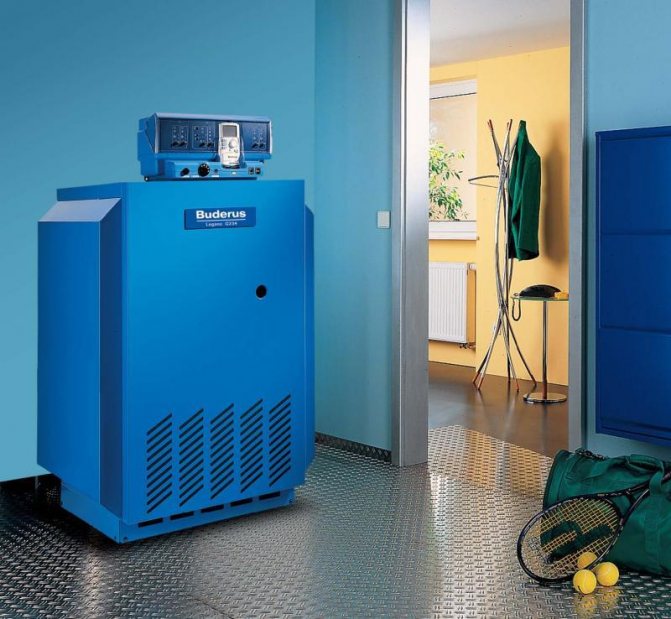

Chimney requirements
- Chimney material - steel. It is recommended to use stainless steel.
- Cleaning hatches and condensate drainage are required. There should be a pocket at the bottom of the chimney in which deposits accumulate.
- The chimney is equipped with external thermal insulation, which is protected from moisture (condensation, precipitation).
- Chimney height - from 5 m and at least 2 cm above the outlet.
- The chimney is installed on the receiving plate of the vapor trap.
- The expansion tank is installed at the highest point in the system.
- A safety group and a thermometer are installed on the supply pipeline.
- It is undesirable to place the device in openings, niches and other hard-to-reach places.
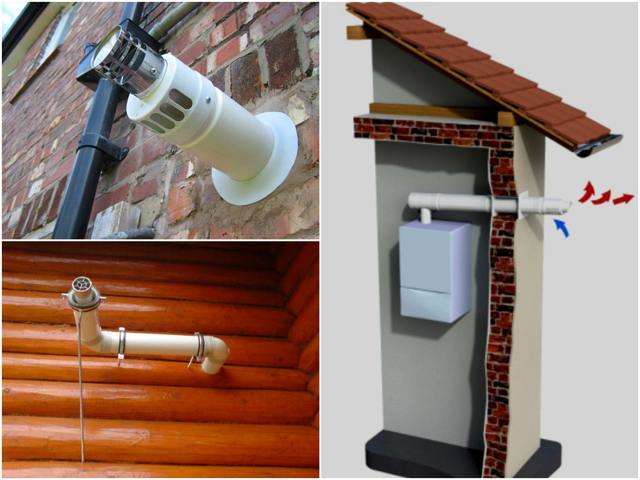

How to use
In modern models of heaters, human participation is minimized. Before the device is started, it is connected to:
- gas pipeline - employees of the gas service;
- heating pipes;
- water supply - representatives of organizations serving heating systems.
The first start-up is also carried out by service workers. If during connection and maintenance the requirements of the instructions are violated, the warranty will be canceled. The equipment must only be used for the purposes intended by the manufacturer.
During installation, maintenance and repair, original spare parts must be used. If a breakdown or incorrect operation is found, the user should immediately turn off the gas with a valve and call the service or gas service. It is strictly forbidden to carry out repair work on your own.
When performing any work on or near an air duct or chimney, it is imperative to turn off the gas. After completing the work, they check the functionality of the chimney and air duct and only then proceed to start the device.
Boiler piping Saturn RPD series
Furnace operating mode. Maintenance of furnaces with solid fuel layer combustion. Solid lump fuel is burned in a layer on the grate of the furnace - a layer combustion method. Manual fireboxes are used only in small and medium-sized boiler systems. The disadvantage of these furnaces is the unevenness of the combustion process and the need for skillful and hard work of the stoker when throwing fuel, conducting the combustion process and when cleaning the grate.
Throwing solid fuel onto the grate should be done quickly, without leaving the furnace doors open for a long time in order to avoid strong cooling of the furnace by the air rushing into it and an increase in heat losses from chemical incompleteness of combustion and with exhaust gases. For the same purpose, when throwing fuel, you should reduce the thrust by covering the smoke damper. The frequency of injections and the amount of thrown fuel depend on the boiler load, the type of fuel and the size of its pieces.
The injection should be done more often, but in small portions, since the lack of air at the first time after loading and the excess air thereafter will be less with frequent injection than with more rare, but large portions, combustion will go more evenly and with less excess air.
There are three ways to drop fuel:
Only a properly executed piping of the boiler is able to make it work in full measure, to ensure the supply of heat to the heating devices.All boiler equipment must generate heat, and for this, it is necessary to connect the distribution network to the boiler using additional devices in accordance with all standards.
It consists in shifting most of the heat from the front of the grate to the back to the threshold and throwing fuel onto the front. The release of volatile components from fresh fuel lying only on a thin layer of heat will be slow. The released volatile components, passing over the burning fuel lying farther and meeting the air passing through it, completely burn out; The air passing through the burned-out fuel on one half of the grate is used to burn the flammable volatiles released on the adjacent half with fresh fuel.
This method is applicable for wide grates with vertical gas outlet for both sintered and non-sintered coals; horizontal water tube boilers;. This method gives the most favorable results for vertical venting of gases. If there are several loading doors, the fuel is loaded through each door in turn, after the fuel previously thrown into the next door has ignited well.
Correct and economical combustion of coal can be seen by the straw-yellow color of the flame and by the light gray haze coming out of the chimney. If the combustion is incomplete, then the smoke turns black, and dark tongues appear in the flame. During work, burnout, noticeable by the brighter color of the layer, and slagging, causing a darkening of the layer, must not be allowed.
With an excessive excess of air, the smoke disappears, and the flame becomes dazzlingly bright. A shortening of the flame means the end of the combustion of volatiles and the need to load a new portion of fuel. The air supply should be regulated by blowing and traction, being guided by the above signs, or according to the indications of devices - a gas analyzer and traction meters.
The most advantageous CO content in waste gases is determined based on the results of commissioning. To control and regulate the operation of the furnace, two differential traction meters must be installed. One combustion gas meter shows the resistance of the grate with a layer of fuel, the other boiler pressure meter shows the resistance of the gas ducts.
In case of burnout or too thin a layer of fuel, the resistance of the grate and the readings of the furnace draft meter decrease, while the resistance of the gas ducts and the readings of the boiler draft meter, on the contrary, increase due to the increase in the amount of flue gases. When slagging or too thick a layer of fuel, the resistance of the grate increases, and since the excess air will be less, the resistance of the gas ducts will decrease.
Changes in the readings of the traction meters, the reasons for the changes and the measures taken are given in table. How the readings of the traction gauges change at the same time.
In the case of main gas supply, this must be done by a gas service employee. Heating supply.
Why the readings of the traction gauges change compared to normal. The full text of the document will be available to you as soon as the payment is confirmed. After confirming the payment, the page will be automatically refreshed, usually it takes no more than a few minutes. We apologize for the inconvenience caused. If the funds were debited, but the text of the paid document was not provided, contact us for help: payments kodeks.
If the payment procedure on the website of the payment system has not been completed, funds will NOT be debited from your account and we will not receive confirmation of payment. In this case, you can repeat the purchase of the document using the button on the right.
In the piping of boiler plants, various elements are used, each of which performs its assigned function.Some provide circulation of the coolant, others distribute or block it, others are responsible for filtering or compensating for the expanding volume of liquid. There are also devices that prevent accidents in emergency situations. In this article, we will highlight the question of what role the boiler safety group plays in the heating system, what it consists of and how it is installed correctly.
The payment was not completed due to a technical error, the funds were not debited from your account. Try to wait a few minutes and repeat the payment again.
If the error persists, write to us at spp cntd. Personal data privacy policy. Document text Status. Search in the text.
RD Typical instructions for the safe conduct of work for the personnel of boiler houses Document name: RD Typical instructions for the safe conduct of work for the personnel of boiler houses Document number: Type of document: RD Adopted body: Gosgortekhnadzor of Russia Status: Effective Published: official publication Series Documents on safety, supervisory and ... IN.
It also protects the boiler heat exchanger from hydraulic shocks. If the house is large, then after the separator arrange a collector comb.
How to turn off the boiler correctly
If the device will not be used for a long time, perform the following actions:
- Close the gas valve.
- If the equipment is volatile, disconnect the automation and the water pump from the mains.
- Shut off the water supply and heating valves.
- If the temperature is expected to drop below zero, you will have to drain the water.
- Call a specialist to permanently turn off the equipment.
The heater is also turned off for cleaning. Clean it with a damp cloth, mild detergent and soap. It is forbidden to use aggressive substances.
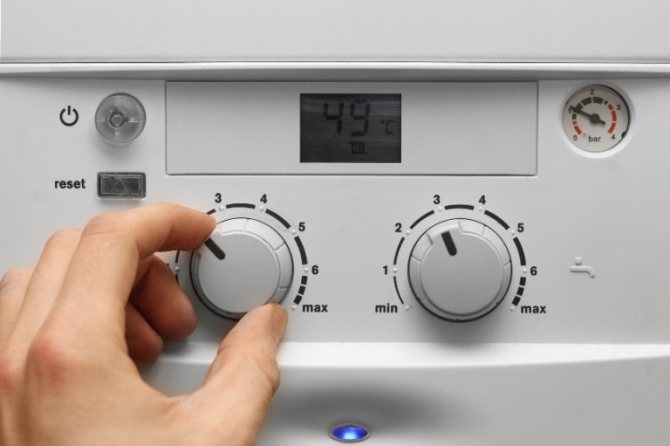

General operating instructions
Before starting to operate the gas boiler, it is necessary to connect it to the gas network, heating pipes, cold and hot water supply (if the unit is double-circuit and is also designed for hot water preparation), the electrical network, which must meet the technical characteristics of the machine. Gas connection is carried out only by certified employees of the gas service. Water is connected and the boiler is first started by representatives of a specialized organization for the maintenance of heating systems. When connecting, strictly adhere to the requirements of the warranty card and operating instructions, otherwise the warranty will be canceled.
A gas boiler can only be used for the purposes for which it is intended.


Table of the required volume of the boiler room depending on the boiler output.
The manufacturer is not responsible for improper operation of the boiler, violation of operating rules and for damage associated with this. This will also void the warranty.
Installation, service and other work must be carried out in full compliance with the normative and technical documentation and user manual. Only original spare parts should be used.
In the event of a malfunction and / or breakdown of the unit, the gas supply must be immediately shut off by the valve and a qualified technician must be called in. It is strictly forbidden to carry out any work on the gas boiler yourself.
When carrying out any work with air ducts and chimneys or near them, it is necessary to turn off the device and turn off the gas. After completing the work, before turning on the boiler, check the functionality of the air ducts and chimneys.
When you turn off the gas boiler for a long time
- turn off the gas valve;
- when the boiler automation is powered from the mains and there is an electric water pump, disconnect them from the line;
- turn off the taps of the cold and hot water supply system, the heating system;
- if the heating system is filled with water and the ambient temperature is expected to drop below 0 ° C, the water must be drained from the heating system;
- the final shutdown of the unit must be entrusted to a specialist.
When cleaning the boiler, turn it off. The device may be cleaned with damp cloths with mild detergent and soapy water. Do not use aggressive chemicals for cleaning, including detergents, insecticides, and other toxic substances.
It is strictly forbidden to use and store flammable substances in the same room as the gas unit.
Safety system
Gas powered appliances need serious monitoring. It is provided either by a person or by an automation system. The latter is capable of providing multi-stage protection that prevents dangerous situations and increases the safety of the equipment. The main task of the protection system is to turn off the device in time by stopping the fuel supply.
Let us consider the protection stages using the example of a floor-standing boiler "Proterm Volk KSO". These modern devices have multi-stage protection. One of the stages is an ionization sensor that monitors the flame. If the fire goes out, a signal will be given to the control unit, it will cut off the fuel supply and prevent an accident.
The combustion chamber has a temperature sensor that monitors the heating of the coolant and does not allow the furnace to burn out quickly. "Wolves" are equipped with a KTD system - chimney draft control. It prevents the accumulation of carbon monoxide gases. If there is no draft, the accumulation of combustion products in the chimney begins, the thermostat heats up. When the temperature limit is reached, the thermostat contacts open - the flow of fuel stops.
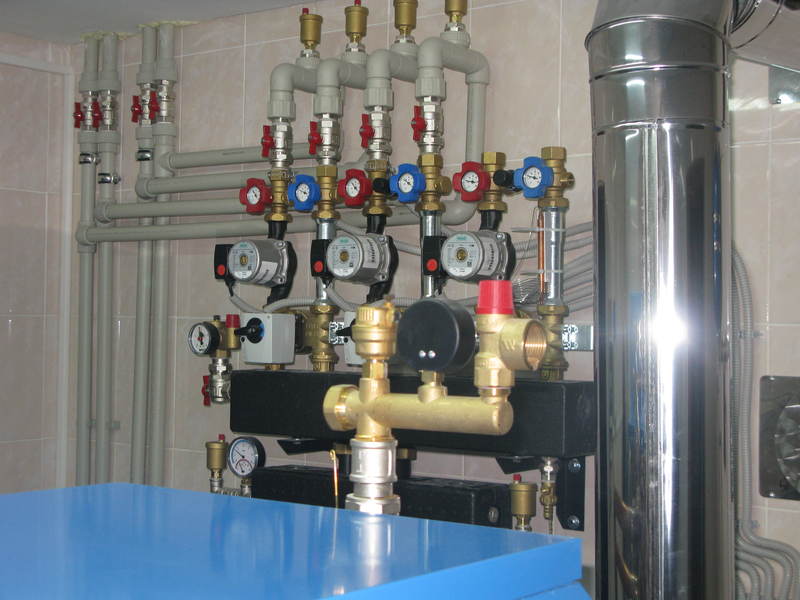

Automatic protection
Modern heater models are saturated with electronic instrumentation that generates signals for the control unit. Automation, receiving signals from sensors, coordinates the work of all units. Safety valves, expansion tanks, air valves, smoke detectors and other devices are the elements that prevent various kinds of malfunctions and problems.
Gas facilities
Manufacturing instruction
- the main document according to which the boiler room personnel must act. It stipulates general rules and specific actions of personnel in a given situation.
The given instruction is an example of a typical instruction for boiler room operators. The instruction is given to each operator personally, under signature.
The main points of the production instructions for the operator of the gasified boiler house:
I. General Provisions.
- The procedure for admitting an operator to work
- The rights and obligations of the boiler operator
- The admission of unauthorized persons to the boiler room is allowed only if accompanied by the head of the boiler room with the permission of the administration.
- It is forbidden to engage in extraneous activities on duty.
II.Preparation for firing up (kindling) the boiler.
- The boiler is fired up only with a written order from the head of the boiler room.
Preparation for firing up the steam boiler
- It is necessary to make sure that there are no people and foreign objects in the boiler furnace and gas ducts.
- Check the integrity of the boiler and chimney lining.
- Check the condition of the explosive safety valves.
- Check the serviceability of the safety valves (by detonating).
- Check the condition of the boiler headset.
- Test drives for air dampers of smoke exhausters and fans.
- Check for natural draft in the firebox.
- Check the serviceability of the exhauster and fans.
- Check the condition of the boiler headset.
- Check the serviceability of the pipelines connected to the boiler. Make sure that there are no plugs on the pipelines.
- Check the serviceability of the shut-off valves on the boiler pipelines (supply, blowdown).
- Check the serviceability and activation of the water-indicating glasses.
- Check the serviceability of the instrumentation.
- Check the operability of the automatic regulation.
- Check the health of the safety automation.
- Make sure that the backup feed pump is working.
- Close the shut-off valve on the steam line.
- Open the air vents on the upper drum of the steam boiler.
- Close the taps on the drain lines.
- Close the valve on the continuous blowdown line.
- Make sure there is water in the deaerator.
- Fill the econamizer with water.
- Open the valve on the supply line.
- Fill the boiler with feed water (For a steam boiler, the water level should be between the lower permissible level and the upper permissible level, slightly above the average value.
- Make sure that the water level in the boiler does not drop.
- Close the valve on the supply line.
Preparation for firing up a hot water boiler
- Check the condition of the boiler headset.
- Check the serviceability of the pipelines connected to the boiler. Make sure that there are no plugs on the pipelines.
- Check the serviceability of the instrumentation.
- Check the health of the safety automation.
- Check the serviceability of the network pumps.
- Close the taps on the drain lines.
- Open the valve on the boiler inlet line.
- Open the valve on the boiler outlet line.
- Open the air vents. Wait until water flows steadily from the air vents and close them.
- Make sure there is water circulation through the boiler. The inlet water pressure must be higher than the outlet.
- Make sure there is no water leakage from the boiler.
- Fill the system with water using the booster pump.
- After creating pressure in the system, about 2.5 kgf / cm2, turn on the circulation pump.
- Make an entry in the log about preparing the boiler for firing up.
III.Ignition (kindling) of the boiler.
- The boiler is fired up according to the written order of the head of the boiler room.
Firing up the steam boiler:
- Make sure that the boiler is full of water.
- Check the tightness of the shut-off valves. Record the results of the check in a removable log.
- The steam shut-off valve on the boiler must be closed.
- The valve on the continuous blowdown line must be closed.
- The valve on the boiler feed line must be closed.
- Open the valve on the squeegee line.
- The air vents on the steam boiler must be open.
- Ventilate the furnace and gas ducts.
- Check the serviceability of the water-indicating glasses.
- Check the serviceability of the safety valves (by detonation method)
- The boiler is fired up at minimum load.
- The boiler is fired up at minimum load.
- Close the air vents after steam has flowed steadily from them.
- At a steam pressure of 3 kgf / cm2, once again check the serviceability of the water-indicating glasses, check the safety valves by the detonation method.
- Periodically purge the boiler.
Ignition of hot water:
- When firing up the boiler, observe the pressure and temperature at the inlet and outlet.
- Monitor the water flow through the boiler. (by flow meter)
- Record the ignition result in a removable log.
IV. Putting the boiler into operation.
V. Boiler operation, maintenance.
- During the operation of the boiler, it is necessary to monitor the condition of the boiler, the operability of the safety automation, and the control and measuring devices.
- It is necessary to observe the operating mode of the boiler in accordance with the regime card and the temperature schedule.
- Monitor the burners. Burning must be complete and stable.
- It is necessary to control the operation of pumps, exhausters and fans.
- Periodically monitor the temperature and composition of the flue gases.
Steam boiler operation:
- It is necessary to maintain a normal water level in the steam boiler, to ensure uniform water supply to the boiler. The water level should be at the horizontal axis of the upper drum.
- Perform periodic blowdown once per shift.
- It is necessary to control the work of the economizer.Monitor the pressure and temperature of the water entering and leaving the economizer. Write to the shift log at least once per shift.
Hot water boiler operation:
- During the operation of the boiler, it is necessary to monitor the water temperature at the inlet and outlet of the boiler. The water in the boiler must not boil.
- Observe the pressure at the inlet and outlet of the boiler.
- It is forbidden to leave the boiler equipment unattended until the fuel has stopped burning and the boiler has cooled down.
VI. Scheduled boiler shutdown.
- Should be carried out by written order of the head of the boiler room.
- The planned shutdown of the boiler is carried out with a gradual decrease in the load on the burners.
- Disable continuous blowdown.
- Shut off the gas supply at minimum load.
- If the steam pressure in the boiler continues to rise, open the safety valves.
- If the temperature of the water in the economizer rises, open the discharge line.
- Ventilate the furnace and gas ducts - 10 - 20 minutes.
- After completion of ventilation, turn off the smoke exhauster and the fan, the directions must be closed.
- On a hot water boiler, you can turn off the water circulation when the water inlet and outlet temperatures are the same ..
- The boiler must be supervised until it cools completely.
- Record information about the planned shutdown of the boiler in the shift log.
Draining water from the boiler:
- The water is drained from the boiler according to the written order of the head of the boiler room.
- Open the air vents and shut-off device on the drain line and drain the boiler.
VII. Emergency stop of the boiler.
- An emergency stop is carried out immediately, without a gradual decrease in the load and without the written permission of the head of the boiler house.
Emergency stop of the steam boiler:
- Extinguishing the flame on the burner.
- In the event of a safety valve malfunction.
- Extinguishing the flame on the burner.
- Failure of all feed pumps of the steam boiler.
- Raising the pressure in the boiler drum above the permissible level by 10% with the continuation of the increase.
- Decrease in the water level in the upper drum below the lower permissible level.
- The water level in the upper drum rises above the upper permissible level.
- Failure to operate all water level indicators.
- Disable fans.
- Shutdown of smoke exhausters.
Emergency stop of the hot water boiler:
- The increase in water pressure at the outlet of the boiler is higher than the permissible one.
- The decrease in water pressure at the outlet of the boiler is below the permissible value.
- Raising the water temperature at the outlet of the boiler to a value of 20 ° C below the boiling point (in accordance with the working water pressure).
- Malfunction of the safety automation.
- Power outage.
- A fire in the boiler room. In the event of a fire, personnel must act in accordance with these instructions and the plan for the elimination and localization of emergency situations.
- Make an entry in the shift journal about the time and reason for the emergency stop of the boiler. Report to the head of the boiler room.
VIII. Reception and delivery of the shift.
- Inspect all equipment in operation, as well as in reserve and under repair.
- View all log entries since the last watch
- Find out the current situation in the boiler room orally.
- Make an entry in the journal about the acceptance of the shift.
IX Final Provisions
- The boiler house maintenance personnel is responsible for violation of the requirements of the production instructions in accordance with the requirements of the internal labor schedule - material, administrative and in accordance with the legislation of the Russian Federation.
What to do if malfunctions appear
Let's consider situations with breakdowns using the example of Italian Baxi boilers. Italian wall and floor heaters are an example of quality and efficiency. But even with proper use, malfunctions may occur that require prompt elimination.
The following problems may appear in Baksi models:
- the burner does not light up;
- while working in the firebox, pops are heard;
- the boiler has overheated;
- the device makes a lot of noise;
- the sensor is out of order.
The probable causes of breakdowns are associated both with violations of the operating rules and with reasons beyond the control of the user:
- moisture has entered the device;
- low quality of the coolant;
- decreased pressure in the gas pipeline;
- voltage drop in the power grid;
- errors were made during installation.
Violation of at least one rule or norm leads to breakdowns, incorrect operation and unnecessary costs.
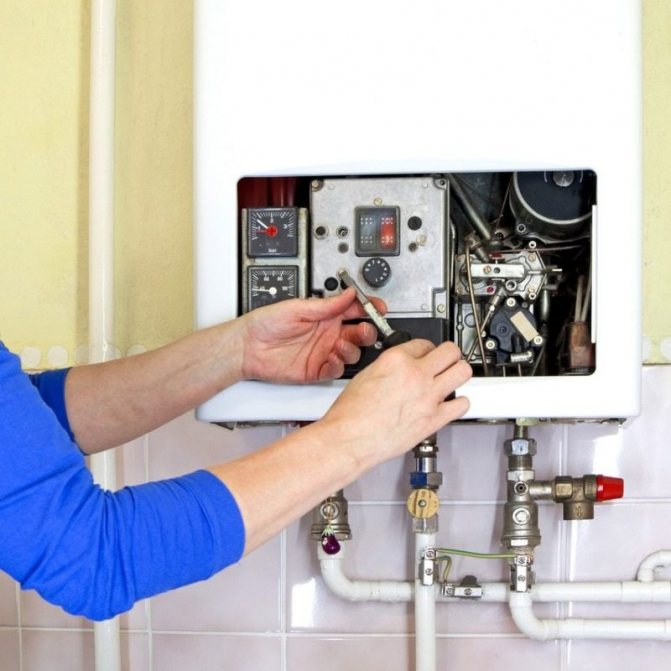

Features of the installation of a liquid fuel unit
Oil fired boilers are complex and potentially hazardous systems. It is best for specialists to install them in strict accordance with the instructions attached to the device. When installing the equipment, you should pay special attention to some of the steps.
An overview of popular models of liquid fuel boilers is presented in this material:
Stage # 1 - arrangement of pipelines
In most devices, the outlet to the heating system is equipped on both sides, which greatly facilitates the installation procedure. Therefore, one of them is used for its intended purpose, the second is equipped with the so-called emergency assembly. The design is designed to protect the boiler against excessive pressure. As soon as it becomes dangerous, the safety valve is triggered. It is best to remove a hose or drain pipe from the valve and connect them to the sewer. It must be remembered that there should not be any additional valves between the emergency assembly and the boiler.
Stage # 2 - selection of a circulation pump
It is designed to maintain the circulation of the coolant in the system. The device can be installed both on the return pipes and on the supply. It depends on the installation scheme. In some boilers, separate wires are provided for connecting the pump. Their power may not be enough for several devices, then they are connected to the outlet regardless of the heater. Each pump must be installed strictly in a certain position, which is indicated in the passport for the device.
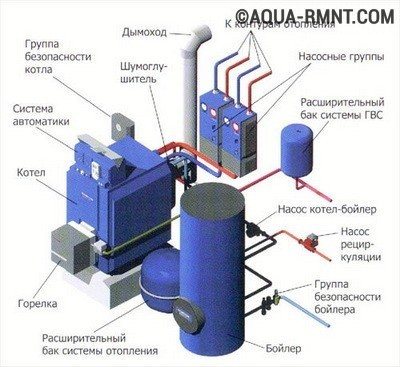

To connect an oil boiler, it is necessary to install and connect several elements shown in the diagram
Stage # 3 - installation of a strainer for water purification
Such a device must be installed in the direction of fluid flow in front of the pump. The system cleans the water from sufficiently small mechanical particles that are always present in the liquid. Over time, they damage the pump and clog pipes inside the boiler or in the heating system, which leads to system failure and subsequent costly repairs. It is much cheaper to install a filter. Its maintenance boils down to regular cleaning of the device every few months.
Stage # 4 - installing the chimney pipe
The efficiency of the boiler depends on how correctly the installation of the structure is carried out. In case of installation errors, it will often clog up with soot and soot, and work intermittently.
The most common mistakes when installing a chimney are:
- The use of non-separable joints. For the system to function properly, it must be cleaned at least once or twice a year, which is extremely difficult or even impossible for a one-piece non-separable structure.
- Narrowed chimney diameter. In this case, the longer the pipe, the faster it will become clogged with soot. Too frequent cleaning of the structure will be required.
- The absence of a counter slope, which is created to prevent condensate from entering the boiler.
- Use of flexible metal corrugation for gas evacuation. Such a system is unreliable. When it burns out, exhaust gases begin to flow into the room, which is unacceptable.
For oil boilers, coaxial or traditional chimneys can be equipped. In any case, the structure is manufactured and installed in compliance with all standards.
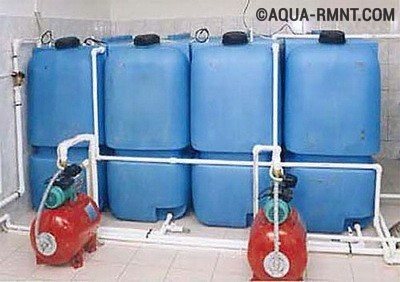

Experts recommend equipping fuel tanks with special taps located at the bottom of the tank. So it will be possible to drain the condensate without any problems.
Stage # 5 - installation of fuel tanks
The tanks can be installed in the boiler room or anywhere else. The first option is preferable, since the fuel does not freeze or paraffin even in the most severe cold weather. In this case, one should not forget about fire safety.
Tanks without a booster fuel pump must be at least 30 cm above the lower boiler level. If the main tank is located outside or dug into the ground, an intermediate tank must be installed in the boiler room, in which the fuel will be warmed up and unnecessary impurities can precipitate.
Stage # 6 - filling the heating system with water
The procedure is carried out with the shut-off valve fully open. The pressure should be in the order of 1.5-2.5 bar. After the system is full, the connection between the water supply and the boiler is disconnected, otherwise the water from the heating system will contaminate the water supply. In order not to damage the equipment, it is not recommended to add various inhibitors to the coolant. Subsequently, the water level in the system is constantly monitored. The method of making up the system with water will be explained by the specialist installing the heater.
Making a waste oil boiler can be an interesting choice. Drawings and assembly instructions for this unit are located here:
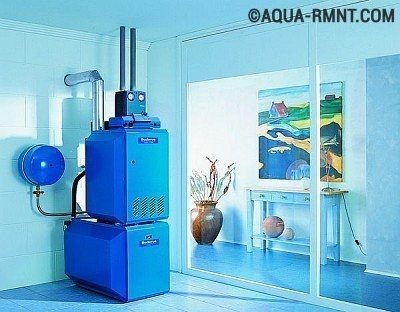

Liquid fuel appliances must be located on a solid, non-combustible base that can support the weight of the appliance and the heating medium.
Frost protection
One of the important rules for operating heating systems is to ensure the minimum permissible temperature of the coolant. If water is poured into the system, then at low temperatures freezing occurs, pipes and radiators become unusable. In modern models, this problem is solved - the user is relieved of the need to monitor the coolant.
So, for example, in boilers of the South Korean] Navien [/ anchor], reliable protection against freezing is provided. "Navien" is cheaper than European counterparts, but these boilers have all the necessary protection functions, which greatly simplifies use.
When the temperature of the heating medium drops below 10 ° C, the circulation pump starts automatically. If the coolant cools down to 6 ° C, the burner automatically turns on, heating the coolant to 21 ° C.
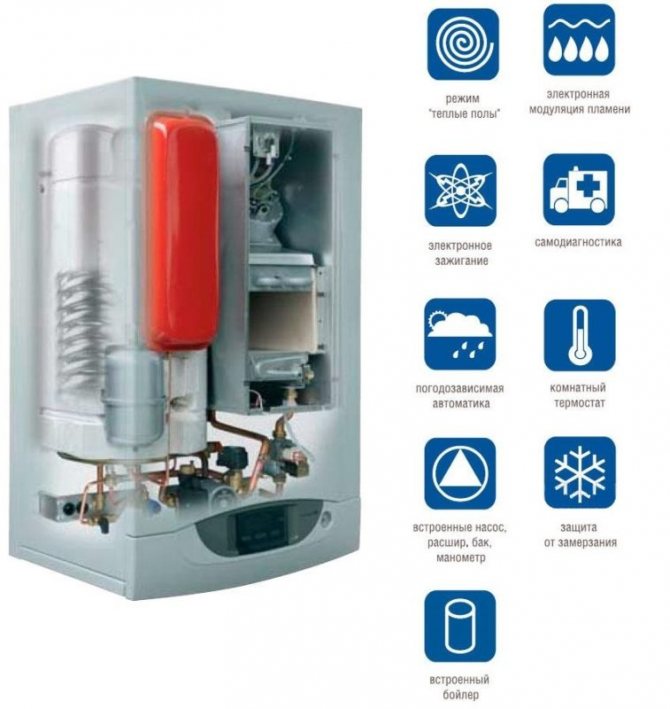

How to correctly place a gas heating boiler in a house?
When installing a gas boiler for the heating system, it is necessary to take into account the fire safety rules, because this will help to avoid problems in the future.
Low-power gas boilers
up to 60 kW can be installed in kitchens.
Boilers up to 150 kW
can be installed in any room regardless of the floor, including the basement and basements. Boilers of atmospheric type can only be installed in basements and basements, since natural air draft is necessary for their operation.
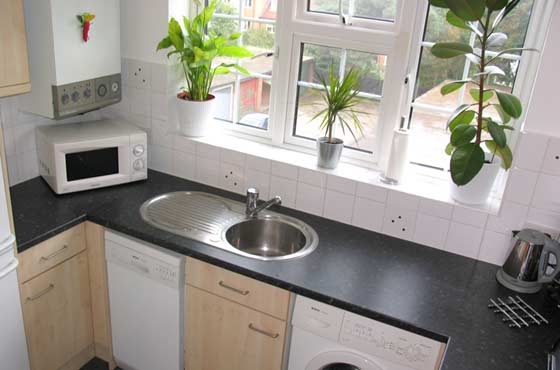

Low power boilers are commonly used in the kitchen
Boilers up to 500 kW
it is allowed to install only in separate rooms of the basement or basement floor or in separate annexes to the house.
Ignition instructions
Heaters differ in the type of ignition, so there are nuances when starting different modifications. Before turning on the device, you need to read the ignition instructions in order to do everything right. Let's consider firing up on the example of the Italian boiler "Ariston". It is important to check the system for leaks before switching on. For this purpose, the thermostat is turned on to the maximum so that the changeover is automatically triggered. Ariston ignition process:
- the device is connected to the mains, and the heating regulator is set to the desired temperature value;
- a small noise is heard when the pump is turned on;
- when all air jams are eliminated in the pipes, the noise will disappear;
- electric ignition is triggered - the boiler turns on independently.
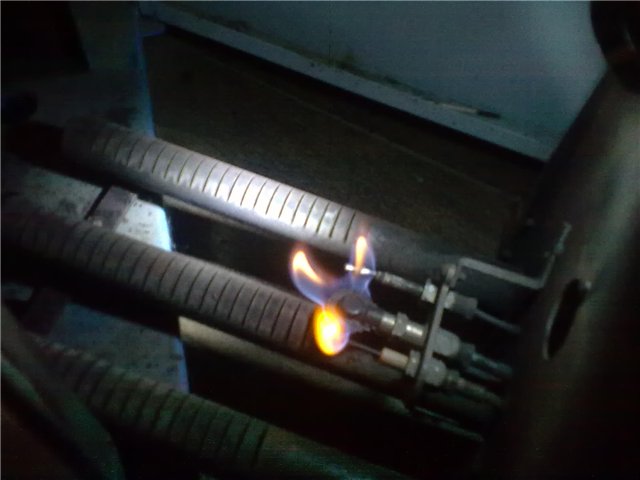

Self-diagnosis
The operation of the heaters is simplified if they have a self-diagnostic function. Almost all European manufacturers have equipped their products with it.
So, for example, German heaters "Bosch", displaying error codes on the display, allow the user to quickly understand the cause of the problem and take measures to eliminate it. If code A7 appears on the screen, it is clear that the hot water temperature sensor is faulty.
If A8 is highlighted, the connection to the BUS bus is broken. This function greatly simplifies the use of gas equipment, makes it easier and more comfortable.
Dangerous situations
The greatest risk is burner malfunction. If the flame goes out, gas can accumulate in the room, which will subsequently cause an explosion. Reasons for extinguishing the fire:
- the gas pressure has dropped below the permissible rate;
- there is no draft in the chimney;
- the supply voltage has disappeared;
- the igniter went out.
In an emergency, it is necessary to immediately shut off the fuel supply to the burners - automatically or manually. Modern versions are equipped with automatic devices necessary for prompt shutdown of equipment. The operation of such devices is not only convenient, but also safe.
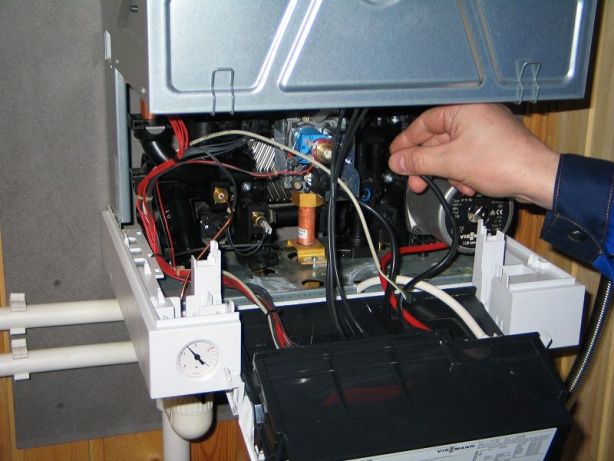

How to prevent gas build-up in a room
Modern safety standards provide for the installation of gas analyzers in boiler rooms, they are necessary for signaling when gas appears in the room. A special electronic valve reacts to their signals, automatically stopping the flow of fuel to the burners.
Instructions for the operation and repair of gas boilers, piping diagram.
Save the article for yourself or share it on your favorite social networks:
Instructions for the operation and repair of gas boilers, piping diagram.
Gas type heating equipment is a complex system that must be operated in accordance with all rules and regulations. If we refer to the issue of independent use of single-circuit and double-circuit gas equipment carelessly, then this can threaten not only a sharp reduction in the life cycle of the system, but also a real danger for you and your family members.
The rules that must be observed concern not only the moment of operation, but also the moment of installation of gas devices, which must be carried out by professionals. Also, preventive actions, which should be carried out annually, are of no small importance. Service maintenance is carried out at least once every three years. When calling specialists in order to check your gas boiler, the instruction (manual, manual) for it should be at your fingertips.
Preventive work
As already mentioned, periodic maintenance of gas equipment is not only desirable, but also strictly necessary. This is a principled point. Particular attention should be paid to the burner, monitoring its correct operation and behavior in emergency situations. Also, the condition of electronic boards, speakers, hoods, wiring, ventilation, grounding and boiler is checked. It is strongly recommended to involve in urgent work professional specialists who have been trained in import or domestic courses and have an appropriate license. Do-it-yourself maintenance does not guarantee the absence of emergencies that pose a risk to human life. As part of preventive work, procedures should be carried out to control the serviceability and integrity of the heating equipment components. Failure to do so could result in gas leakage and an explosive situation.
Automatic protection
In expensive equipment, automation is responsible for the safety of the system, which must also undergo annual preventive procedures.As a rule, a typical scheme of a gas heating boiler from reliable manufacturers implies equipping gas equipment with a variety of sensors designed to monitor a number of parameters, including the presence of draft in the chimney, the presence of a flame for the burner, the ability to automatically turn off in case of an unforeseen situation, etc. To protect the boiler from overheating, it is necessary to periodically bleed the air that has entered the system. This air will form an air lock that will impede the normal circulation of gases and liquids. For this, either a manual or an automatic valve is used.
Repair of gas boilers
As a rule, repair procedures for domestic gas equipment begin in the fall. In hot summer, hardly anyone uses the boiler for its intended purpose. But with the beginning of cold days, when a person decides to light the wick, he may not ignite. How can this aspect be explained? It's simple. Either the wick is damp or the gas pipe is clogged. And if your boiler system is equipped with automation, then one of the electrical sensors may fail, which will prevent a full start. What to do in such cases? If the wick is damp and does not want to ignite, it is strongly not recommended to disassemble the boiler system on your own. You can easily provoke an explosive situation, or disable expensive gas equipment. Remember that the smell of gas is not always obvious. If you do not feel it, then the next time you "teal" with a lighter or a match, there will be an explosion. Therefore, immediately contact the specialists who, with the presence of a license, guarantee you safety, reliability and high quality. Remember, only a specialist, and not just a familiar person who previously worked in the gas service, can provide you with a good and safe repair. I think you understand even without feedback on the forums that it's better not to joke with gas.
In order to avoid problems with calling the master, it is better to take a boiler of a popular brand. For example, it can be ariston, aogv, baxi, navien, proterm, vailant, ferroli, junkers, danko, daewoo, electrolux, bosch, viessmann, mora, demrad, arderia, termona, hermann, hefest, junkers, zhytomyr, neva lux, rinnai, oasis, buderus, senor duval, keber, hearth, cheetah, don 16, signal, kiturami, celtic, imergaz, hydrosta, alpha color, tribute, zhmz, western, siberia, wolf, herman, alexia, mimax, bear.
Step-by-step diagnostics
A specialist who comes to you for warranty or service maintenance will have to carry out a series of diagnostic procedures within one to two days. The safe operation of gas boilers will be verified by the following work.
1. Checking and cleaning the flow-through heat exchanger. The master blocks the wall (hinged) or floor boiler from the side of the DHW draw-off circuit, as well as from the side where the water came from. After that, liquid is drained from the circuit. Next, a complete check of the circuit connection of the water draw-off is carried out for the presence of scale and for contamination of the heating circuit, the boiler piping diagram is checked. If necessary, the heat exchanger is cleaned or completely replaced.
2. Testing of sensors. All sensors, including water and heat exchanger temperature limiters and monitors, are checked in a specified sequence. The cables are previously disconnected from the sensor, after which it will be possible to use a universal measuring device in order to measure the transmission of currents with a temperature limiter. If the sensor fails, dismantle it and install a new sensor, remembering to lubricate its surface with a paste with heat-conducting characteristics.
3. Testing the thrust tipping controller. The check involves the complete disconnection of the flue pipe from the draft stabilizer. Next, the front panel is installed, the chimney connecting pipe on the traction stabilizer is closed.The boiler then starts up at maximum output. The controller must shut off the burner for a maximum of two minutes. If this does not happen, then you will need to check the sensor for operability. Replace it if necessary. If, after replacing the sensor, the controller does not turn off the burner even after 15 minutes of operating the boiler at full power, the entire controller will have to be changed, then take the boiler system out of operation, free the hole and connect the chimney pipe to the traction stabilizer. After completing the checks, disconnect the mains voltage.
Strapping diagram:
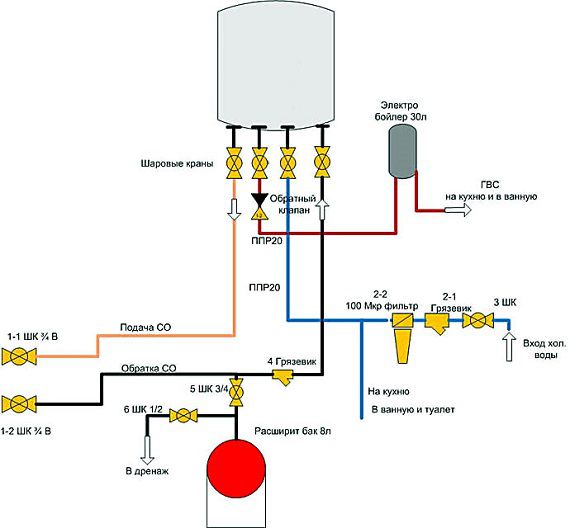

Other useful information:
Choosing a chimney for a gas boiler
Maintenance of gas boilers
Device and characteristics
Comments, answers to questions
- Alex I am looking for detailed information on the operation of a solid fuel TT boiler, as well as diesel, wood and steam, so that I can compare before buying.
Reply
What other safety rules are there?
- Do not disassemble or dismantle gas appliances yourself.
- Handle the power cord with care.
- Do not place foreign objects on top of the appliance.
- Do not step on the boiler. Do not step on chairs, tables or other unstable objects to clean the wall-mounted kettle.
- Watch the coolant, add it to the system in time.
- Be careful - in some modifications the use of antifreeze is prohibited.
- If you smell gas, immediately turn off the gas, open windows and doors. Exit the boiler room and call the gas service.
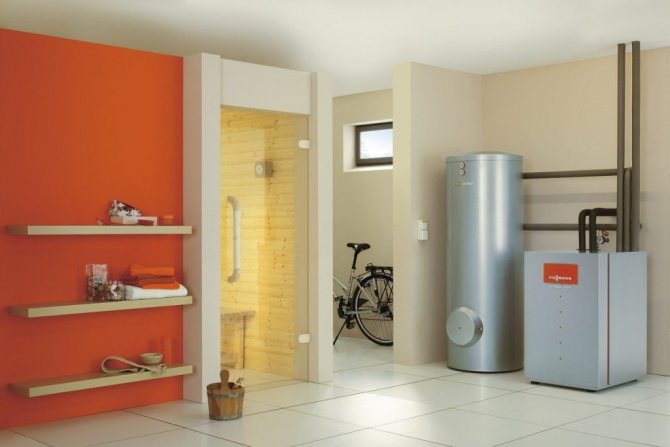

In order for the operation of a household gas boiler to be safe and uninterrupted, the user must familiarize himself with the instructions for it in advance. Choosing models equipped with automation, the consumer increases the comfort of use and safety. Observing the rules for the use of gas appliances in everyday life, for their installation and maintenance, the number of emergencies can be minimized.
Safe operation of the gas boiler
Methane is lighter than air, and propane (LPG), on the contrary, is heavier. When a leak occurs, the first rises to the ceiling, and the second drops to the floor. In order to exclude a dangerous concentration of gas and to avoid an explosion, it is necessary to provide for natural ventilation in the first case with an exhaust opening at the top, and in the second with a vent at the bottom of the wall.
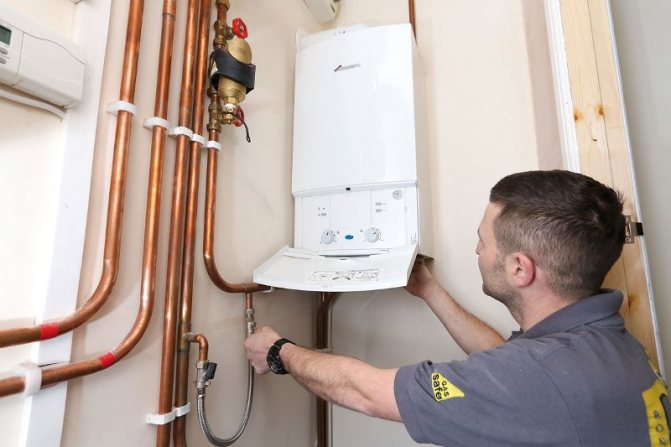

In winter, when the heating boiler is turned off for a long time, the water from the device and pipes must be drained so that it does not freeze and, when expanding, does not damage the heating system
When cleaning, use only non-aggressive detergents to clean and wash the outside of the column. Also, do not use abrasive powders and coarse brushes.
To avoid problems during the operation of a gas boiler, you should:
- Purchase the device and fittings for it only from a trusted company.
- Install all equipment exclusively factory-made.
- To entrust the primary installation and connection of the column to the masters from the gas service serving the house or village.
- Regularly inspect the boiler for corrosion and deterioration, and at least once a year carry out a full technical check.
- Ensure sufficient air exchange (with low air flow or with poor exhaust air, the burner in the combustion chamber may go out).
- Avoid placing various foreign objects on the gas appliance.
- To constantly avoid overheating of the unit, monitor the level of the coolant and water in the boiler.
- For a volatile boiler, provide an uninterruptible power supply with a capacity of at least 12 hours and a separate line with an RCD.
- Be sure to connect any gas equipment to the ground loop.
Also, in addition to built-in automation, it is recommended to install various security systems that shut off the gas supply when certain problems are detected.
By law, the mandatory installation of methane (propane) leak sensors in rooms with a boiler is not fixed.But by all safety rules, their installation is highly recommended.

